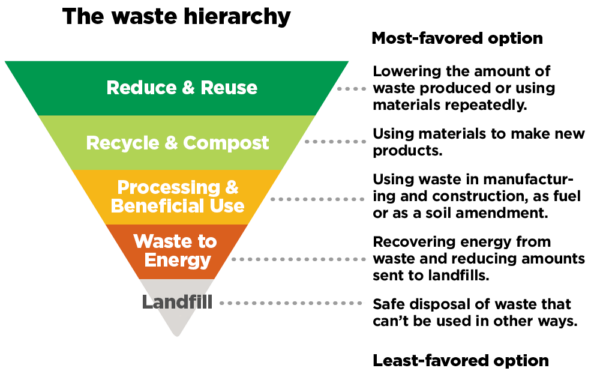Reduce, reuse, recycle…then PERC
For us, it’s all about sending the right waste to the right place.
While our core business is turning waste into energy, there’s a lot of waste we don’t want—material that can be reused or recycled into new products and organic material that can be composted or turned into biofuels.
Only then do we want what’s left—waste that we can use to generate renewable power, reducing it 90% by volume to make sure as little as possible goes to the landfill.
And even then, we go the extra step of removing and recycling metals contained in the ash that is left from the combustion process.
 Maine’s solid waste management hierarchy is not just good policy, it’s now the law, thanks to the strong support of PERC and others.
Maine’s solid waste management hierarchy is not just good policy, it’s now the law, thanks to the strong support of PERC and others.
For more information about the hierarchy, visit Maine’s Solid Waste Management Hierarchy at the Maine Department of Environmental Protection website.
Learn more about processing organic waste from our friends at Exeter Agri-Energy.
Honored for environmental stewardship
PERC is permitted to discharge millions of gallons of treated wastewater per year into the Penobscot River. Our actual discharge was a fraction of that, but PERC employees thought they could do even better. They took the initiative to reduce our wastewater discharge to zero by recycling and reusing all the water we use in our operations.
 This achievement was recognized by both the U.S. Environmental Protection Agency (EPA) and the Maine Department of Environmental Protection (DEP). In 2016, the EPA presented PERC with an Environmental Merit Award, given annually to recognize outstanding environmental advocates who have made significant contributions toward preserving and protecting our natural resources. Later the same year, the Maine DEP presented PERC employees with the Governor’s Award for Environmental Excellence, given to companies and organizations that have gone “above and beyond” to protect Maine’s environment.
This achievement was recognized by both the U.S. Environmental Protection Agency (EPA) and the Maine Department of Environmental Protection (DEP). In 2016, the EPA presented PERC with an Environmental Merit Award, given annually to recognize outstanding environmental advocates who have made significant contributions toward preserving and protecting our natural resources. Later the same year, the Maine DEP presented PERC employees with the Governor’s Award for Environmental Excellence, given to companies and organizations that have gone “above and beyond” to protect Maine’s environment.
Taking things to a new level
Subsequent to achieving zero discharge, we have gone even further: we are now using rinse water from a local manufacturing business in our anti-slagging system. Because this rinse water was previously discharged as wastewater, the PERC plant is now a negative-discharge facility.
In addition, we have taken metals recycling to a new level by investing in a system to recover more metals – both ferrous and non-ferrous – from the ash left in our boilers after waste incineration. The recovered material represents nearly 25% of our total ash disposal by weight and an even higher percentage of ash by volume. This means less ash going to the landfill and increased revenue from recovering a valuable resource.
